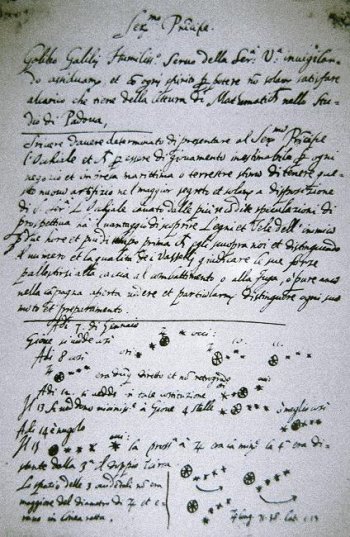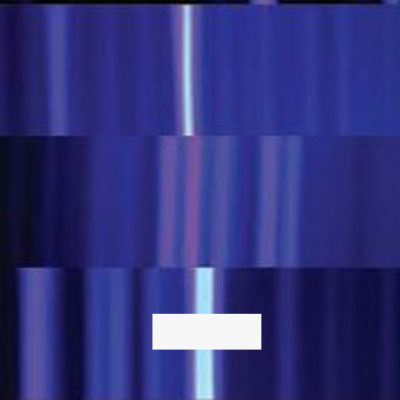Chapter 13. Orbits of the Galilean Moons
13.1 Introduction

Author: Jordan Raddick, Johns Hopkins University
Editor: Beth Hufnagel, Anne Arundel Community College

The goals of this module: After completing this exercise, you should be able to:
- Recognize the four Galilean moons (Io, Europa, Ganymede and Callisto in order of increasing distance away from Jupiter) traveling with Jupiter around the Sun.
- Compare the apparent speeds of a Jovian moon at different parts of its orbit as seen from Earth, and explain why the variation is mostly an effect of watching the orbit from the side.
- Measure the approximate orbital period of Io.
In this module you will explore:
- What Galileo observed about Jupiter's moons.
- How orbits appear when viewed from the side.
- How to recognize different moons from observations
Why you are doing it: Galileo's observations of Jupiter's four largest moons in 1610 were the first definitive proof that Earth was not the center of the universe. They also helped astronomers realize that Copernicus's Sun-centered model of the Solar System was better than an Earth-centered model. (Simon Marius claimed that he had observed them first in 1609, but Galileo published first. In addition, Marius had already been suspected of plagiarizing from Galileo two years before1.)
1Albert Van Helden, The Galileo Project, http://galileo.rice.edu/sci/marius.html, accessed September 26, 2007.
13.2 Background
In the early 1600s, astronomers were still not sure about Earth's place in the Solar System and the Universe. Since ancient times, astronomers believed that the Earth was at the center, and that the Sun, planets, and stars all orbited around Earth. In 1543, Nicolas Copernicus proposed a model in which the Sun was at the center of the Solar System, and all planets including Earth revolved around it. Scientific models are judged by the predictions they make, and Copernicus's model predicted the positions of the planets just as well as the ancient models. There was no way to easily decide between the models, so many astronomers stuck with what they knew.
In 1608, an Italian scientist named Galileo Galilei heard about a new invention called the telescope that allowed people to see things that were very far away. Galileo decided to build his own. The next year, he began making observations of the Moon and stars.
On January 7, 1610, Galileo looked at Jupiter through his telescope. He discovered four bright stars next to Jupiter. He thought that Jupiter would leave them behind as it continued in its orbit, but the next night, he still saw them next to Jupiter!
He watched them for a week, and they stayed next to Jupiter. He checked ancient records; no one had ever seen these "stars" before. Could the mysterious stars be moons orbiting Jupiter, just as our moon orbits Earth?
In this tutorial you will see the moons of Jupiter, just as Galileo saw them in 1610.

13.3 What Did Galileo See in 1610?
The animation below shows what Galileo would have seen in his telescope. These are the actual positions of Jupiter's moons on January 7, 1610. (False colors have been added to the moons to help you see them better.) Click the play button to play the animation from beginning to end. It shows the positions of the moons once per hour from 1800 Coordinated Universal Time (UTC) to 0700 UTC the next morning, which was about the time Galileo could have seen them. Click the pause button to pause the animation at any point. You can also click the step forward buttun to move forward by one hour or the step backward button to move backward by one hour. You can also click the stop button to reset and start the animation over from the beginning.
Observe the animation carefully, and answer the questions below.
Question Sequence
Question 13.1
AXr0OAKq+VpVn5XLF0hT/JqWzJS2CxJjoLGUeIIveZGsoEmhJcR+mwzL0AmlapbPVCwXksaXk71insLw42OYpoi4M5QJMaglE0CMzTxeFPEFUgrnTy5z5T33PvXHr7hqtaIWeKx6HYZ4hOwyMH7eg4GxEUNPt0cFBmq17TM66DTKJA9wybwcaboHcTrVeL2cr2SF77Kb7GNnaNue3njk5CyS47C60yBWvzKnTA==Question 13.2
9F19cSLSs26lkGXZ+SI2mS9z0arB10i5pEIZ2kdN+F+iCRauUu+VQzBgEjesoQViSDFierZ9Gjj873H3J7GmYlLH8Hr4sfXr7+u9FOnAl4v4hyce5UC+4C7djF/Rk3A2Dl+lSecmdWeAYDoP8SLfLot3/JuTyKzW5Bsjw2R1djEZ7MIagzw86Lve2pFEX4cEp24XwQuBNGRloECR2/ZECVe5M+9/od4SUyn6n5C/1A3s2/uAkfONtJ9yRjWthYS7YHpfxu9WlfkW8tSe42MOeSE2uSx7+d15jDeDjvzE5VZFS9H1peDg6y5vEEY7M/nWUvVza0kBdHuIOlq5BocbeTlReBAOl0Tr910ZVGsB94gJxazeQuestion 13.3
1Q1Smv0QD1c+cX3DW00L9/xYQAgrNBTluDaShrCl2UU5bLd8tWLM+3JNgu4xio6Aftzx6eCVUge8wKfpNybb+mEx7M+C37tcD7Wx7vl+MI8XeyTkbvC0yv6Q/kM9Ofqad9XyWo3IvAIZRQtiAI4dcBIeozJUmye6+IjARjq4gAaPwD4rUlN73ruIpo86+26BPPXVKy7ZJ7wXoPhl98d1ya0URiRI6xL2VIQbvZ4L8Di4WJOCvPMhFSEb3gSfeMyq58mJ6HYNu3YJAWshKDerg8L0ht3nBDL5DShwhU1EoOLNDHr72OjFZLpOU7MIszxVzsdQTHf5VReFRqhFMVsfA5FbBgHEj5m9EDLzoDkpsI+n9A/3C6ER23H4QCKyfEUIfeNV3ER7S92Tg6NdqBdMVEmWrSxCPBOaT8KCx3U+NH3xyxLsYHdKudT4aJxd91IDRIEa6cfJCs5KV/BfRZNefa5blSOhGJ2latCnA4xJhUc+sL8HmzOHHJDQSCXObpOWjQwoLVn2gWCB6s7jFVHgidrxKUDKxAzBol0aFeWw9hAd6A0OULYAuXs/SIfBknfu5h4ynw==Question 13.4
NmeRxKSa24SBjrijMEzjaoUCT8MwBW7Zww9BmA1Wtn7yKUDieKQgJ5PCAtf+i5vFOdo6pcF75zd7I02564v/O6SaRHchYZM00B6W8nAqajAfghoRpe7JlX6rsmYIVhKt9FKieE1uaPUDjlxhx1vQzLK+5bEkqlXlOYVWWPReyOzPQR2dAxU/Ukrn+BaSa+eawe5wZjraF0gMMRWO5KCuMHYWmbLitPj+V8mD/VcaYNQT0kqLSrEQMRAiJApLr/z390n1aXOonQiagdXg0WOjbjtqZFV3GOsBuxrqrQkL41kFQ1AeqTWyffcpFek2gL2sgKx+10etNQuhSOWDby4rttgmQDlbYJa5X5pCmu8i8e9qUwKDicEeV2WMdeCvm78pNUHK2I91iQ9XKMblBdSsY8EHcp7oz6nPIAL282d1VF7wvRhICHzWEK6Q6hOcLqMPbVVYBeOZBX9hwRsfivkp0fClb7DUGmJKoAbV3/lNpgJGI3QdloxRgLP5xi10fZGa556PJkjYggn0jiSCb/aHmcZ11cgnwCWufhlztPlgFsrOW3rGgwMBC9PSADnaZvgelmi3GbHKhggH9a2rCCILcqIOy7h/wAZUQWbmhqXzCX5zcGHJEtw6xY9vcir7nMgkCcp+MKVLAzlXpwqOMktZ583RjFVluPRP5bnDiSvuGz67w6jN3WnyScCOtx7XvZ3IFMuSV5JaaoOhdregVPcQqgwVfM0dLeoP7xi0et/UizdKuawUbd/HsfOXt4NyBRnyU49aU/mMvEmE8VMmEsyxoL2ThjTfak93/8SKiyOddNVH3archANH5rJb+v4JTIObbrXsR5v65GtqBfFZaLsHj4wUznHQEju+ZaMra3/Bq+fcWbFhYseJkyhtZltFENmk9D6XGZ9JUpBrdxtSD5GCIEPrcMB46EzUq9R+6MbO5ZLXQI1w+IAgxbihJRS9oPp33SLAHyE3puS3FEKllVSYklRf2XkMe0pBloY3JAJEViLs3loHwI2izYRhyz4P5KmJQuestion 13.5
Ot4h43xBMwWVXSqqjdUx+VJWnEZ1EHK/AsrCQHPJoSyg32w6+jGuPgt+iI6nojbpgLllzGikGPHmtZtEZp7JHb2AZeEpwlr7E6tkoHw2Uax3nDRQ1BQ4Hn7FQnr2+9Tl+N0N54q6Y3YdppHywqTHKd800aICMnFQS1ClESITMrvvLEowy4nZ4IGwDSybhAsIqBtV9dflUwAW3vEXtmgUdHBvKjN9YZrrzKBqAl7K+6Emm/qBkaJ94Bwjae28kMHuCdZWEhhr7rQokqLLSCDg0n8MlvL6zArK4lRRlMymzQw2GPmdbKSLPXm2mCGB/o2s/1e/sw==Question 13.6
e8BLInfiklpCWRUr1mg7rcwSIoQmtvhlC5+eTX8G2MJ+e2N9XVy41k2nQSQLfXiTQ5HD/2ODFRAawMtUbie+NYKmjGaxiCpMyDi8YlNUE26rrZ/S/rVYizIfhO1Pu8KA/jK9CanV6m3o/oFYjreMKvFjVupIJVLba4oeywSI5jocso/aV/dwIGZp8vZT85v43gTdKlYBs+LKEhL9yY6CY3K1aVL/N7+mtZK+ilmYnlM2dM1y5rkQA34Yo9qtvMoDdBWJZZyKO+ADuHJkXIsCZlVyfXwvuh9Vsb20ca9L5Rbq1svvTV9/G3mcqrFDnae59ZpDIVpPh9EWqnRisVjfb0UqPXvP5+kWgVw5nEUicugj13pmL5swm4E4wi2gpQWxwQhsbv6FJTg2hBGXf6USvJl5/jPxEV0/N50sAZ9WErxS7ljzN3FiGlkH9Xq0CDqeSGvCKkPCoSeGfDVEgI0hgMA7fxWkyzWwN4IMs8SNBWZy12K+oPmM9qK6YBQVq/9wUvTmXznlbYYec4eQfovKe2nYfnb4l0RQwzkSzkNXa4u3F8JCe8WpTvXqCXBsJmto2QT/6RYp7ZGHPw9SFxO8N+O0T4li/OCfmcUjDJAsoWKbI22bosogKTiqMCAKPdd3DqcMihsrgbH8HC+2H+asoOlTHFozjQa1RRv0ZjYGYhVquZf5eyI4eKbRetbFDsuMVz+Ti0jSE9u6YRKW+vmoOOYlQc6dESgfTvVYWUqLUaew42Dl5qZjAyozhSvq31lWi9QkBgOPgxtg6GA3cosG6xxhDEWTJFIGUt6LYEeLU9YvX6ImZWYXqOF6Ksf339gynGp2XXr869O9LrVmDld/vvTqJh2yWdvz72N46c7gtOEKwASWyOz8/Hdv7ajZFK/RN25CsjpP/e2kSAIi+Dhtda9qYbLJgtJ0WSRfQw==Question 13.7
Rpue51xieAtsiFpU2RRTMImdNJPJpxtR8OMB1Kq009a864/3b6ZarUOfUaxK/8Spwz60MwXenge9SwYwcdw+san49m1qljE5rT/U5bC0tCvisgqGnpHJHVN4VMHXIM13q0HQcwjAt5A47vLvwwfP4UQmmeaien9YbgBoeca2VNMgJhz4D3L3X1wRM6cC4dL8GvwpxylF3Z1EiM2ipssabxrZY7NA4Z1Gzl/GW+jkGdIK7ErJqUyuIUPq9RK3h7UA5I19tFEVyV0kP5G+cubvBAgb6rNEBDHlm4FhbYFHSGRzvHyW1cwDnj/bYcPZyEBl8d0WP4uL+aMOhD0XYLo5b/+T7xCG6ORNh62yFSTcTSj+XXx/Zzw2kfAv+OMea5WRxJxniWRVuupeb1kEQMsxAgbnTysRQzGHXdyBWN3CiKhL/IHT8OnzCNjx4hMfg5sypy/uLALPZGzwPOkuF+iKPjqdXeYXB+gxXHBNEZ686xKbfcqHWyvwRrqVpUF/xVlwjyHe4kHjWH6t//sEXCxqs1YKmeabXGW+pk/QE1jADvxxTRvoSj5ci3ndjqpNWCo3UEzjoSsHY43amVjD3N9pfPZKE4iUtRV2LsplZYfCWAf2tg+mqLEBQcL59lDCl7LXCm8CK+R2C5cVEyqxDnO8AsZJIh+Ba3IfyA+9bjavZkU=Question 13.8
oZa5GGnS57r6fBieHCjc6sw0nl29s2o71Jfzkv0Ey932lprNolgpIQQ049lGV3Rhpmh6Wx8S1RbqmAfti4AtSGDwnfPWbJ5jehglQtltN0tLh31vtk8drmRlIx479qS0zzEFVJBuf6li0HylQO+dcrV5m1PKopwLIo3cjs9oAwlhcobmimFcJBNNM8X9Z8WUl04FfvC4IPiRWvUWQLxPuxlAAo53Q5SrNvXvnA==13.4 How Would the Orbits Look from Above?
In the last section, you looked at the four largest moons of Jupiter as Galileo saw them over a period of nine days. You noticed how the moons appear to move faster when they are close to Jupiter, and slower when they are far away from Jupiter. Play the animation again, but this time click on the Top View. This is the inferred explanation for how the Jovian system looks from above the North Pole of Jupiter - confirmed centuries later by NASA's Galileo Mission!
Question 13.9
f/yEBOSNlyaVwn/Hu8tAyBbCXkvFXhpHQE9/1I/wdKntszm+1Vfed9MZw3zN1q8F7EN5EBqwlGnUE93dZU7C2spUqoYtYpBodHW2T82Z397Q9Z7vSug988uT3IweuhCQYCAZH0oepgObmUVAeIQMbfp6VaEtxxECghNAILS9ei9iGh5MsHIznQMTSpHosMfZMTD7uV/5L/Ew0vSNizqYulzARIWft3IvfAK2iTLlqys2/3SNQG+yuo6gP5DmJYXf7oVZsXAlySFkBOQKpKdbK4ifkbV0qd8ZQSME/7mYwcTWKIM8c/fV9jZtemETQtjJGAPGfA4qCBPGWn5I4jSv+rpMSJTZNHG5OfZ7oFZMR/B05XsXb8znBjfUNlx8vg+yaThXkCFbHw33oh7gZdbL4axtby7ZmKKe+UU3Q8KTT1OeXR5UD4mw+OUAqzG9p1jhdEhHJYWk3amfed7kxhuOAC0n4asfW9NheDOE9YvRkto2hhQtDr+S+GRpUyAMajgbxE5Xhpi2qzAhSmwzUQhbrFzdFk8rJwgeKr6Wt8NJZQxGxdnwYMz2+4cbouxec1H/sa198l6QRVidAgyCMv6//5Sq0FzWMNO32YF+BvfdwurFDJYCfVdyhKweDwUUJ+6Z2rPkaTaEtzQCvPFEOpnfGb+lWMRQcXMYLDn2DTIZx7eu3j2zCgyK3+migViSC0p4vKQzBwK+Oz5bAJ9613.5 Evidence for a Sun-centered Solar System
You have seen the four Galilean moons moving as Galileo saw them. You learned in the Background to this activity that astronomers in Galileo's time did not agree on whether the Earth or the Sun was at the center of the Solar System.
Question 13.10
Q4BkWyL0Sz7hMBWEuZ6NVHizfCIAN4L+S8fuewJRcKOkD794jYZLp1hQ1g40T3BC8OSz/qBgMRqzSCuVvQ7wrRshgQ/dFyAa1Migqyw9Gy1nJjXE2/GTCbTRkYNPZiwF7lhaMVE5YRmZVDB1CJHS3oaYMzV9rmUGblZ3wCVJwMykJi8dPyxun5+Yc/0VWMudo/JgNMhumaxtT1WkybfjcKD2oo1Hm9EENPKafy7e5yvW+G6zryztWtOExRw82Gv9h/hzz3vd7Ubv+Ob6uPuRCnIS85c/hdWBro/YiUDxUeu6UILu5cR3KjwWc2ckON+mGf5OsVZEL1+CfYti4li6dn+qRpeH7s6So90hi4UgegQU8TNSe3e5ihJepIFksFOWm5y3FAimVytpuwQRd7e2MoS07/zrT64+ItrDdCCTviVq2K93r/nxf2iOlET8gfywo31z9SngMlg/C/1y+RgMwbcVwkbGCiYbClVAwTlbjEwqmhOSMBryXFDgBGFKIcRwiETlNF+e5FFnLKhhvdI+hjOh2RBUwbo4hk7cCluXCDJ6zY93ez/PoXFwXqaIEI5ScdElwIZMqBOb8R3tgzTtDvoQ2pFAnVtvdZDCQs2OQL4dIWy5bSWANdIxZoE40NSCETJQCQ4NcRsxSP0yDDvbMn7HkhN3HtL6j2zBE+jz6xwlsuCTjNopbidP/uIE9Iu9kxGgCmm/PTG3fwidA9ld7aycpQ69fGUqB2xa8FszyyKaIBosJ7GdEM95sHcQdI2NH/daNa9YV2jrdAdSVGO6bRx3YTIEnfxRNHdqlicykpMzNxSTchoY5eXraxOI698Z13.6 What Did the Galilean Moons Look Like to Modern Probes?
The animations below show simulated views of what the Galilean moons looked like to the Galileo space probe when it flew by the moons as part of its exploration to Jupiter. As you can see, we can get a totally different view from robotic missions than Galileo could with his telescope on Earth. Our view of these moons has certainly changed since 1610!




13.7 Quick Check Quiz
Indepth Activity: Orbits of the Galilean Moons